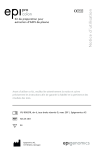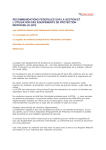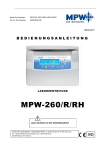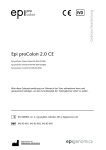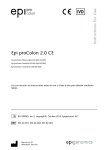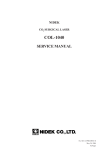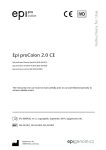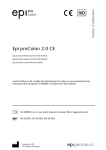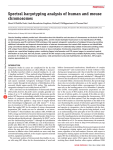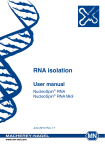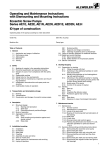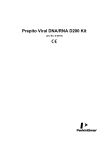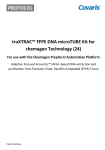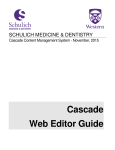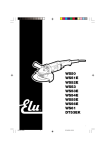Download The instructions for use must be r and followed
Transcript
The instructions for use must be read carefully prior to use and followed precisely to achieve reliable results. IFU 0002GB, GB, rev 6, copyright ©, March 2011, Epigenomics AG M5-01-001 24 Epigenomics AG, 10178 Berlin, Germany Content 1. Important Note.............................................................................................................3 2. Intended Use.................................................................................................................4 3. Product Description.......................................................................................................4 4. Technological Principles................................................................................................ 4 5. Contents....................................................................................................................... 5 6. Instruments, Supplies and Reagents Required but not Provided.....................................5 7. Safety Information.........................................................................................................7 8. Storage and Stability..................................................................................................... 8 9. Test Materials and Preparation for Analysis.................................................................... 8 9.1. Preparation of Working Solutions.................................................................................. 8 9.1.1. Preparation of Epi proColon Proteinase Solution.................................................... 8 9.1.2. Preparation of Epi proColon Carrier Solution.......................................................... 8 9.1.3. Preparation of Epi proColon Bis Reagent A Solution............................................... 9 9.2. Sample Preparation....................................................................................................... 9 9.3. Plasma Preparation........................................................................................................9 10. Experimental Protocol................................................................................................. 10 10.1. Lysis and Extraction............................................................................................. 10 10.1.1. Thawing of plasma (only required if frozen material is used)................................ 10 10.1.2. Lysis.................................................................................................................... 10 10.1.3. DNA Binding....................................................................................................... 10 10.1.4. DNA Washing......................................................................................................10 10.1.5. Elution................................................................................................................. 11 10.1.6. Storage of extracted DNA....................................................................................11 10.2. Bisulfite Conversion............................................................................................. 11 10.2.1. Bisulfite DNA Purification..................................................................................... 12 10.2.2. Binding Step........................................................................................................12 10.2.3. 1st Wash............................................................................................................. 13 10.2.4. 2nd Wash............................................................................................................ 13 10.2.5. 3rd Wash.............................................................................................................13 10.2.6. Drying................................................................................................................. 13 10.2.7. Elution................................................................................................................. 13 10.2.8. Storage of bisulfite treated DNA.......................................................................... 13 11. Quality Control........................................................................................................... 14 12. Limitations of the Procedure........................................................................................14 13. Performance Characteristics........................................................................................ 14 14. References................................................................................................................... 14 15. Contact Support......................................................................................................... 15 Page 2 of 15 1. Important Note Important: Users should familiarize themselves with the instructions contained in this booklet and the components of the Epi proColon Plasma DNA Preparation Kit prior to use. Meaning of Symbols: Consult Instructions for Use Order Number In Vitro Diagnostic Medical Device Lot Number Expiration Date Manufacturer Store at indicated Temperature Number of Tests Keep away from Sunlight Page 3 of 15 2. Intended Use The Epi proColon Plasma DNA Preparation Kit contains reagents for the preparation of bisulfite converted DNA from human EDTA plasma suitable for real-time PCR for in-vitro diagnostic purposes. The Epi proColon Plasma DNA Preparation Kit includes reagents for DNA extraction, DNA bisulfite conversion, and post-bisulfite DNA purification. Performance of the Epi proColon DNA Plasma Preparation Kit has been validated for use with the Epi proColon real-time PCR Kit (M5-01-002). 3. Product Description The Epi proColon Plasma DNA Preparation Kit is used for the extraction of DNA from 3.5 ml plasma followed by bisulfite-conversion of the purified DNA. After a final purification step, the DNA is suited for the analysis of methylation patterns by real-time PCR amplification. The principle of detection of methylated DNA is comprised of three steps, starting with a plasma sample that is prepared from whole blood using standard techniques. DNA methylation occurs predominantly on a CpG dinucleotide, a cytosine nucleotide followed by a guanine nucleotide. DNA contained within the plasma sample is extracted using magnetic bead-based nucleic acid extraction. The extracted DNA is then chemically converted to reveal the methylation status using sodium bisulfite. This chemical treatment converts unmethylated cytosines in CpG dinucleotides to uracils while the methylated cytosines remain unchanged, resulting in a single base-pair change at each unmethylated cytosine. The primers, blockers and probes used in a subsequent PCR reaction are sensitive to these base-pair changes and will discriminate between methylated and unmethylated sequences. 4. Technological Principles The extraction of genomic DNA contained in patient plasma is based on the binding of freefloating genomic DNA to magnetic particles, which are then magnetically separated from the plasma. Remaining impurities are removed from the magnetic particles during the washing steps. In the elution step purified DNA is removed from the magnetic particles by dissolving in elution buffer. The eluate containing genomic DNA is then subjected to a chemical reaction that specifically alters unmethylated cytosine residues within the DNA. Bisulfite treatment is utilized as the method of choice for analyzing DNA methylation. This method allows various downstream applications as the sequence context remains intact. The conversion is based on the nucleophilic addition of a bisulfite ion to a cytosine target and a subsequent deamination reaction to yield uracil sulfonate, while 5-methylcytosine (methylated cytosine) does not undergo the deamination reaction and remains unchanged. Complete conversion of unmethylated cytosines and high DNA integrity after treatment are the critical parameters for sensitive measurement of DNA methylation. Incomplete denaturation prior to treatment and harsh chemical conditions during the reaction have been identified as the most common pitfalls of the procedure. The work flow protocol maintains DNA in a singlestranded form and uses gentle chemical conditions to ensure complete bisulfite conversion, high DNA yields and low degradation of the converted DNA. After purification of the DNA by binding to magnetic particles and washing to remove impurities, the DNA is suited for use in downstream applications. Page 4 of 15 5. Contents The Kit contains reagents for 24 preparations of DNA from plasma: Reagent Containers Volume Epi proColon Extraction 1 1 bottle 90 ml Epi proColon Extraction 2 2 bottles 130 ml each Epi proColon Extraction 3 1 bottle 39 ml Epi proColon Extraction 4 2 tubes 1300 µl each Epi proColon Magnetic Beads 2 tubes 1100 µl Epi proColon Carrier 1 tube -- Epi proColon Carrier Diluent 1 tube 210 µl Epi proColon Proteinase 1 tube -- Epi proColon Bis Reagent A 3 tubes -- Epi proColon Bis Reagent B 1 tube 860 µl Epi proColon Purification 1 1 bottle 39 ml Epi proColon Purification 2 1 bottle 16 ml Epi proColon Purification 3 1 bottle 8 ml Epi proColon Purification 4 1 tube 1.6 ml 6. Instruments, Supplies and Reagents Required but not Provided l Vacutainer® EDTA Tube (Becton Dickinson, catalog no. 367525) or l S-Monovette® Haematology, K2EDTA 9.0 ml (Sarstedt catalog no. 02.1066.001) l S-Monovette® CPDA/ 8.5 ml (Sarstedt catalog no. 01.1610.001) l Water, molecular biology grade l 50 ml polypropylene centrifuge tubes with conical bottom (e.g. Sarstedt, catalog no. 62.547.254), or equivalent l Safe-Lock reaction-tubes 0.5 ml PCR tubes (e.g. Eppendorf AG, catalog no. 0030 121.023), or equivalent l Safe-Lock reaction-tubes 1.5 ml PCR tubes (e.g. Eppendorf AG, catalog no. 0030 120.086), or equivalent l Safe-Lock reaction-tubes 2 ml PCR tubes (e.g. Eppendorf AG, catalog no. 0030 120.094), or equivalent l Pipette tips with aerosol barrier (e.g. VWR International GmbH 612-1430, KOEHK0518, 613-2658) , or equivalent l Tube rack for 50 ml tubes and 2 ml tubes (VWR International GmbH, 50 ml catalog no. 211-0200; 2 ml catalog no. 211-0213), or equivalent Page 5 of 15 l Disposable gloves l Magnetic Separator: chemagic Stand 50 k Typ B (Chemagen, catalog no. 303) l Magnetic Separator: chemagic Stand 2 x 12 (Chemagen, catalog no. 300) l Rotating shaker SB 2 (Carl Roth GmbH Y549.1) with rotating plate (Carl Roth, GmbH Y553.1), or equivalent l Waterbath (Gesellschaft für Labortechnik GmbH GFL, Type 1002, catalog no. 1639905902), or equivalent l Vortex (VWR International GmbH, catalog no. 444-1372), or equivalent l Thermomixer comfort (catalog no. 5355 000.011) with dry heating block 2 ml (Eppendorf AG, catalog no. 5362 000.019), or equivalent l Rotilabo® Floating rack for 50 ml centrifuge tubes (Carl Roth GmbH, catalog no. P201.1), or equivalent l Reference pipette sets, 0.1-2.5 µl, 0.5-10 µl, 10-100 µl, 100-1000 µl (Eppendorf AG), or equivalent l 2.3 ml Pasteur single-use pipette (Carl Roth GmbH, catalog no. EA56.1), or equivalent l 6 ml Pasteur single-use pipette (VWR International GmbH, catalog no. 612-4464), or equivalent l Multipette Plus (Eppendorf AG, catalog no. 4981 000.019), or equivalent l Mastercycler (Eppendorf AG, catalog no. 5331 000.018), or equivalent with heatblock suitable for 0.5 ml reaction tubes l Centrifuge 5417 R (Eppendorf AG, catalog no. 5407 000.317), or equivalent l Epi proColon Work Flow Control Kit (M5-01-003) Page 6 of 15 7. Safety Information Always wear a laboratory coat and disposable gloves. Clean contaminated surfaces with water. Epi proColon Extraction 1: contains Guanidine Isothiocyanate; R20/21/22-32-52/53, S13-36/37, S61* Epi proColon Extraction 2: contains Sorbitan-Sesquioleate, Sodium perchlorate and Ethanol; R9-11-22, S13, S16* Epi proColon Extraction 3: contains Sorbitan-Sesquioleate, Sodium perchlorate and Ethanol; R9-11-22, S13,-16* Epi proColon Purification 1: contains Sorbitan-Sesquioleate, Sodium perchlorate and Ethanol; R9-11-22, S7-16* Epi proColon Purification 2: contains Ethanol; R11, S7-16* Epi proColon Purification 3: contains Ethanol; R11, S7-16* Epi proColon Proteinase: R36/37/38-42/43, S22-24/25-37-45* Epi proColon Carrier Diluent: contains Guanidine isothiocyanate; R20/21/22-32-52/53, S13-36/37-61* Epi proColon Bis Reagent A: contains Sodium sulfite and Sodium metabisulfite (Sodium disulfite); R22-31-41, S26-39* Epi proColon Bis Reagent B: contains Trolox, Tetrahydrofurfurylalcohol; R36, S39* Epi proColon Extraction 4, Epi proColon Purification 4, Epi proColon Magnetic Beads and Epi proColon Carrier do not contain harmful components. *R-phrases R 9: Explosive when mixed with combustible material. R 11: Highly flammable. R 20/21/22: Harmful by inhalation, in contact with skin and if swallowed. R 22: Harmful if swallowed. R 31: Contact with acids liberates toxic gas. R 32: Contact with acids liberates very toxic gas. R 36: Irritating to eyes. R 36/37/38: Irritating to eyes, respiratory system and skin. R 41: Risk of serious damage to eyes. R 42/43: May cause sensitisation by inhalation and skin contact. R 52/53: Harmful to aquatic organisms, may cause long-term adverse effects in the aquatic environment Page 7 of 15 *S-phrases S 7: Keep container tightly closed. S 13: Keep away from food, drink and animal feedingstuffs. S 16: Keep away from sources of ignition - No smoking. S 22: Do not breathe dust. S 24/25: Avoid contact with skin and eyes. S 26: In case of contact with eyes, rinse immediately with plenty of water and seek medical advice. S 36/37: Wear suitable protective clothing and gloves. S 37: Wear suitable gloves. S 39: Wear eye/face protection. S 45: In case of accident or if you feel unwell, seek medical advice immediately (show this label). S 61: Avoid release to the environment. Refer to special instructions, and safety data sheet. 8. Storage and Stability 25 °C o 18°CC 18 -15 °C -25 °C Store all reagents of the Epi proColon Plasma DNA Preparation Kit at 18 to 25 °C in the dark. For long term storage (up to 3 months), dissolved Carrier, Proteinase, and Bis Reagent A should be aliquoted and stored at -15 to -25 °C. Avoid freeze/thaw cycles. Reagents provided with the Epi proColon Plasma DNA Preparation Kit are stable until the expiration date when stored and handled as directed. Do not use material past expiration date. Do not mix components from different kit lots. Note: If Epi proColon Extraction 1 contains precipitates, proceed as follows: l Heat Epi proColon Extraction 1 in a waterbath at 50 ± 5 °C for 10 min and shake gently. l Repeat heating and shaking until the precipitate is completely dissolved. l Bring Epi proColon Extraction 1 to room temperature (18 – 25 °C) before use. The brown color of the Epi proColon Bis Reagents is normal and has no impact on their performance. 9. Test Materials and Preparation for Analysis 9.1. Preparation of Working Solutions 9.1.1. Preparation of Epi proColon Proteinase Solution 1. Add 860 μl water, molecular biology grade, to a tube containing Epi proColon Proteinase. 2. Vortex intensively for 1 min. 3. Repeat vortexing procedure until all material is dissolved. 9.1.2. Preparation of Epi proColon Carrier Solution 1. Add 205 μl Epi proColon Carrier Diluent to a tube containing Epi proColon Carrier. 2. Vortex intensively for at least 2 min. Page 8 of 15 9.1.3. Preparation of Epi proColon Bis Reagent A Solution 1. Add 800 µl of water to a tube containing Epi proColon Bis Reagent A. 2. Vortex intensively until residuals are dissolved partially. 3. Add additional 800 µl water. 4. Vortex intensively for 3 min. 5. Repeat vortexing procedure until all material is dissolved. Note: The Epi proColon Bis Reagent A is hardly soluble, therefore it is possible to gently heat the solution (45 to 55 °C). 9.2. Sample Preparation Use a Vacutainer K2EDTA 10 ml tube, S-Monovette® Haematology, K2EDTA 9.0 ml tube or SMonovette®, CPDA 8.5 ml tube for drawing blood. Do not freeze blood samples. Preparation of plasma may be performed up to 24 hours after collection, if blood samples were stored continuously at 2 to 8 °C. If S-Monovette®, CPDA 8.5 ml tubes are used, blood samples may be stored for up to 48 h at 2 to 25 °C. 9.3. Plasma Preparation 1. Disable the brake function in the centrifuge to prevent disruption of the cell layer. 2. Centrifuge the blood in Vacutainer or S-Monovette tubes for 12 min at 1350 ± 150 g. If centrifuge uses RPM (revolutions per minute), refer to the centrifuge user manual for a conversion table. 3. Remove tube from centrifuge. Discard the sample if hemolysis (bright red plasma) is observed. In this case a new blood sample must be taken. 4. Use a Pasteur single-use pipette to transfer plasma from the collection tube to a 15 ml centrifuge tube. 5. Centrifuge plasma in the 15 ml centrifuge tube for 12 min at 1350 ± 150 g. 6. Using a new bulb pipette, transfer 3.5 ml plasma from the 15 ml centrifuge tube to a 50 ml polypropylene centrifuge tube with conical bottom. 7. Start DNA extraction with Epi proColon Plasma DNA Preparation Kit. Alternatively, store plasma samples at 2 to 8°C for up to 18 hours, or at -15 to -25°C for up to 7 days. Page 9 of 15 10. Experimental Protocol 10.1. Lysis and Extraction 10.1.1. Thawing of plasma (only required if frozen material is used) Thaw frozen plasma for 30 min at room temperature. 10.1.2. Lysis 1. Add the following to a 50 ml tube: · 3.5 ml blood plasma sample, or Epi proColon Positive Control, or Epi proColon Negative Control · 3.5 ml Epi proColon Extraction 1 · 5 μl Epi proColon Carrier Solution · 20 µl Epi proColon Proteinase Solution · The total volume will be ~7 ml. Note: Prior to use briefly shake Epi proColon Extraction 1 tube to check for precipitates. If precipitates are present follow instructions detailed in the “Note” in Section 8. 2. Mix by vortexing for 10 sec and place tubes into a 56 ± 2 °C waterbath for 10 min. 10.1.3. DNA Binding 1. Remove 50 ml centrifuge tubes from waterbath and add (in the following order): · 70 μl Epi proColon Magnetic Beads (freshly suspended by vortexing for 30 sec) · 10 ml Epi proColon Extraction 2 2. Vortex intensively for 10 sec. 3. Place 50 ml tubes into a rotating shaker and incubate at room temperature for 60 ± 5 min. Note: A homogeneous suspension of beads in Epi proColon Magnetic Bead Suspension is essential for proper performance. Deviations from the specified amount of beads may lead to -false results. 10.1.4. DNA Washing 1. Place 50 ml tubes into the magnetic rack and allow beads for 5 min to form a pellet. 2. Discard supernatant. Ensure that the supernatant is completely removed. 3. Add 1.5 ml Epi proColon Extraction 3 and vortex intensively for 10 sec. Ensure that the magnetic beads are completely suspended. 4. Transfer bead suspension into a 2.0 ml Safe-Lock tube with a Pasteur single-use pipette. Pulse spin the 2 ml tube to remove drops from the lid. 5. Place tubes into a magnetic separator. Allow the beads to accumulate for 2 min. 6. Discard supernatant with a pipette to the extent possible while taking care not to remove beads. 7. Place tubes into a centrifuge and spin for 10 sec at 1,000 ± 150 g. 8. Place tubes into a magnetic separator. Allow the beads to accumulate for 2 min and remove residual washing solution. Page 10 of 15 10.1.5. Elution 1. Transfer tubes into a non-magnetic rack. 2. Add 100 μl Epi proColon Extraction 4 to each tube and vortex intensively until the magnetic beads are completely resuspended. 3. Place tubes into a thermomixer and incubate at 65 ± 2 °C for 15 min while shaking at 1,400 rpm. 4. Pulse spin for 10 sec to remove drops from lid. 5. Place tubes into a magnetic separator. Allow the beads to accumulate for 2 min. Extend separation time if any beads are present in the supernatant. 6. Transfer the complete supernatant into a 0.5 ml Safe-Lock tube. 7. Elution volume will be ~100 µl. 10.1.6. Storage of extracted DNA If extracted DNA is not used immediately, store material at 2 to 8 °C for up to 24 hours or at –15 to –25 °C for up to 3 days. 10.2. Bisulfite Conversion Note: Always add reagents in the order listed below! Do not pre-mix Epi proColon Bis Reagent A Solution and Epi proColon Bis Reagent B Solution before addition to the DNA. Do not place dissolved Epi proColon Bis Reagent Solutions on ice. Do not carry over beads into the bisulfite reaction. Prepare bisulfite reactions in 0.5 ml PCR tubes according to, and in the order listed below: 1. Add 190 µl Epi proColon Bisulfite Reagent A Solution. 2. Add 30 µl Epi proColon Bisulfite Reagent B Solution. Note: The total volume is approximately 320 µl. 3. Close the PCR tubes and vortex the bisulfite reactions thoroughly for 20 sec. Pulse spin the tubes to remove liquid from the lid. 4. Place the PCR tubes into the deep-wells of the Mastercycler heating-plate. 5. Use the Mastercycler program listed in Table 1. Note: It is important to heat the lid of the Mastercycler to 105 °C during the entire incubation procedure to avoid evaporation of reaction components. Converted DNA can be left in the Mastercycler overnight without any loss of performance. Do not freeze the reaction mixture! Page 11 of 15 Table 1: Bisulfite Conversion Thermal Cycler Program Step No Step Time Temperature 1 Initial Denaturation 5 min 96 °C 2 Incubation 25 min 50 °C 3 Denaturation 5 min 96 °C 4 Incubation 85 min (1h 25 min) 50 °C 5 Denaturation 5 min 96 °C 6 Incubation 295 min (4h 55 min) 50 °C 7 Hold <14 h 20 °C 10.2.1. Bisulfite DNA Purification Prepare the following tubes for each sample · One 2 ml Safe-Lock reaction tube per sample for the washing steps · One 1.5 ml Safe-Lock reaction tube per sample for the elution step 10.2.2. Binding Step Note: The DNA yield after purification strongly depends on the correct amount of magnetic beads being added to the reaction mixture. Resuspend Epi proColon Magnetic Beads by vortexing intensively for 30 sec. Repeat suspension procedure of Epi proColon Magnetic Beads after every 6 samples to ensure the same amount of magnetic particles in each DNA extraction solution. 1. Vortex 0.5 ml Safe-Lock tubes containing the bisulfite reaction mixture intensively for 10 sec. 2. Pulse spin to remove drops from lid. 3. Transfer the complete reaction mixture into a 2.0 ml Safe-Lock tube. 4. Add 1 μl Epi proColon Carrier Solution. 5. Add 1.5 ml Epi proColon Purification 1. Note: Epi proColon Carrier Solution can be mixed with Epi proColon Purification 1 before use to enable the handling of larger volumes. This mixture can be stored at room temperature for up to 12 h. 6. Add 10 μl of thoroughly resuspended Epi proColon Magnetic Beads. Note: A homogeneous suspension of beads in Epi proColon Magnetic Bead Suspension is essential for proper performance. Deviations from the specified amount of beads may lead to false results. 7. Close lid and vortex intensively for 10 sec. 8. Place tubes in a thermomixer and incubate at room temperature for 60 min while shaking at 1,400 rpm. 9. Remove tubes from thermomixer and set the thermomixer temperature to 55 °C. 10. Pulse spin to remove drops from lid. 11. Place tubes into a magnetic separator and allow the beads to accumulate for 2 min. 12. Using a fresh pipette remove as much liquid as possible. Page 12 of 15 10.2.3. 1st Wash 1. Remove 2 ml tubes from the magnetic rack and transfer to a non-magnetic rack. 2. Add 300 μl Epi proColon Purification 2. 3. Close lid and vortex briefly to resuspend the beads. 4. Pulse spin to remove drops from lid. 5. Place tubes into a magnetic separator and allow the beads to accumulate for 2 min. 6. Completely remove supernatant with a pipette. 10.2.4. 2nd Wash Repeat steps 1. to 6. from section 10.3.2. 10.2.5. 3rd Wash 1. Remove 2 ml tubes from the magnetic rack and transfer to a non-magnetic rack. 2. Add 300 μl Epi proColon Purification 3. 3. Close lid and vortex briefly to resuspend the beads. 4. Pulse spin to remove drops from lid. 5. Place tubes into a magnetic separator and allow the beads to accumulate for 2 min. 6. Completely remove supernatant with a pipette. 7. Spin for 30 sec at 1,000 ± 150 g to remove drops from lid. 8. Place tubes into a magnetic separator and allow the beads to accumulate for 2 min. 9. Remove residual liquid with a pipette. 10.2.6. Drying 1. Place tubes with lids open into the pre-heated thermomixer and incubate for 5 min at 55 ± 2 °C. Note: Do NOT over-dry! Longer incubation times may cause lower DNA yields! 2. Remove 2 ml tubes from the thermomixer and transfer to a non-magnetic rack. 10.2.7. Elution 1. Add 55 μl Epi proColon Purification 4 and vortex briefly to resuspend the beads. 2. Place tubes into a thermomixer and incubate at 55 ± 2 °C for 15 min while shaking at 1,400 rpm. 3. Pulse spin to remove liquid from lid. 4. Place tubes into a magnetic separator. Allow the beads to accumulate for 2 min. Extend separation time if any beads are present in the elution buffer. 5. Transfer the complete eluate into a multiwell plate. Alternatively 8-stripe tubes or PCRreaction tubes or 1.5 ml Safe-Lock tubes can be used. 6. Following elution the bisulfite treated DNA can be transferred into. 10.2.8. Storage of bisulfite treated DNA If extracted bisulfite treated DNA is not used immediately, store material at 2 to 8 °C for up to 24 hours or at –15 to –25 °C for up to 3 days. Page 13 of 15 11. Quality Control The Epi proColon Work Flow Control Kit (M5-01-003) contains Epi proColon Positive and Negative Controls. These controls must be included with each assay run to monitor the successful execution of the workflow to ensure validity of test results. The Epi proColon Positive / Negative Control values must be within the validity limits specified in the Instruction For Use of the Epi proColon real-time PCR Kit (M5-01-002). If a control is out of its specified range, the associated test results are invalid, must not be reported and the patients must be retested. If laboratory quality control procedures require more frequent use of controls to verify test results, follow those procedures. 12. Limitations of the Procedure l This product has been validated for use with human EDTA plasma. Using the product on other materials has not been validated and is not recommended. l This product has been validated for use with the Epi proColon real-time PCR Kit (M5-01002). Performance with other downstream applications has not been established. l We recommend using only single-use pipettes and pipette tips to prevent crosscontamination of patient samples. l Haemolytic samples should not be used as the impact of hemolysis on test results is not known. 13. Performance Characteristics The Epi proColon Plasma DNA Preparation Kit has been tested in combination with the Epi proColon real-time PCR kit (M5-01-002) on control materials provided by the Epi proColon Work Flow Control Kit (M5-01-003), on technical materials containing buffered concentrations of DNA, on plasma pools prepared from human EDTA plasma samples and on individual plasma samples. The Epi proColon Plasma DNA Preparation Kit provided bisulfite converted DNA suitable for real-time PCR in more than 99 % of the cases. Performance of the Epi proColon Plasma DNA Preparation Kit has been established with the Epi proColon real-time PCR Kit. For details the user is referred to the Instructions for Use of the Epi proColon real-time PCR Kit. 14. References 1. De Vos, T. et al. Circulating methylated SEPT9 DNA in Plasma is a Biomarker for Colorectal Cancer, Clinical Chemistry 55:7, 1337-46 (2009) 2. Lofton-Day, C. et al. DNA methylation biomarkers for blood-based colorectal cancer screening. Clinical Chemistry 54:2, 414-423 (2008) 3. Gruetzmann, R. et al. Sensitive Detection of Colorectal Cancer in Peripheral Blood by Septin 9 DNA Methylation Assay. PLoS ONE, Volume 3, Issue 11, e3759 (2008) 4. Model, F. et al. Identification and validation of colorectal neoplasia-specific methylation markers for accurate classification of disease. Mol Cancer Res 5, 153-163 (2007) Page 14 of 15 15. Contact Support The Epi proColon Plasma DNA Preparation Kit is manufactured by: Epigenomics AG, Kleine Präsidentenstraße 1, 10178 Berlin, Germany using components from Chemagen Biopolymer-Technologie AG Arnold-Sommerfeld-Ring 52499 Baesweiler, Germany For further information and support send an e-mail to: [email protected] or call: +49 30 24345-222. Page 15 of 15















